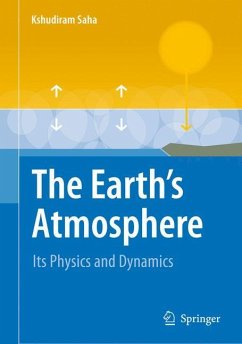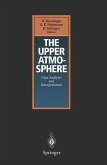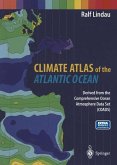The book entitled "Atmospheric science and Global Warming" covers a wide area of the atmospheric science, focussing particularly on those physical and dynamical aspects of our environment which tend to create heat sources and sinks in the earth-atmosphere system and which it seeks to balance through circulation at different time and space scales. The processes of heat transfer in the atmosphere and ocean by general circulation and by waves and oscillations are discussed in detail. The heat balance of the atmosphere is discussed after taking into consideration the role of various types of greenhouse gases that may be present. In this context, the publication of the book will be very timely and is bound to be welcome by all those interested in knowing more about our atmosphere and the way it works, especially in the matter of such a contentious issue as global warming by greenhouse gases released by human activities on earth.
Starting with the origin, composition and structure of the atmosphere, the physics part deals with the laws of heat and thermodynamics of dry and moist air, water vapour and its transformation into different phases and formation of cloud and rain under different stability conditions, solar and terrestrial radiation and their impact on the gaseous envelope in different layers of the atmosphere which create sources and sinks in different parts of the atmosphere especially in its boundary layers. The dynamics part discusses the various types of motion systems including the general circulation and waves and oscillations that operate in order to achieve heat balance in the earth-atmosphere system.
The book entitled " The Earth's Atmosphere - an introduction to its physics and dynamics" covers within its 19 Chapters and in about 450 pages a wide area of the atmospheric science, focussing particularly on those physical and dynamical aspects of our environment which tend to create heat sources and sinks in the earth-atmosphere system and which it seeks to balance through circulation at different time and space scales. The processes of heat transfer in the atmosphere and ocean by general circulation and by waves and oscillations are discussed in detail. The heat balance of the atmosphere is discussed after taking into consideration the role of various types of greenhouse gases that may be present. In this context, the publication of the book will be very timely and is bound to be welcome by all those interested in knowing more about our atmosphere and the way it works, especially in the matter of such a contentious issue as global warming by greenhouse gases released by human activities on earth.
Starting with the origin, composition and structure of the atmosphere, the physics part deals with the laws of heat and thermodynamics of dry and moist air, water vapour and its transformation into different phases and formation of cloud and rain under different stability conditions, solar and terrestrial radiation and their impact on the gaseous envelope in different layers of the atmosphere which create sources and sinks in different parts of the atmosphere especially in its boundary layers. The dynamics part discusses the various types of motion systems including the general circulation and waves and oscillations that operate in order to achieve heat balance in the earth-atmosphere system. Between the two parts, the book offers a comprehensive treatment of the science of our atmosphere.
The author has sought to incorporate in the book some of the fundamental concepts and principles of the physics and dynamics of the atmosphere, a knowledge and understanding of which should help an average student of science to comprehend some of the great complexities of the earth-atmosphere system, in which a thr- way interaction between the atmosphere, the land and the ocean tends to maintain an overall mass and energy balance in the system through physical and dynamical processes. The book, divided into two parts and consisting of 19 chapters, introduces only those aspects of the subject that, according to the author, are deemed essential to meet the objective in view. The emphasis is more on clarity and understanding of physical and dynamical principles than on details of complex theories and ma- ematics. Attempt is made to treat each subject from ?rst principles and trace its development to present state, as far as possible. However, a knowledge of basic c- culus and differential equations is sine qua non especially for some of the chapters which appear later in the book.
Starting with the origin, composition and structure of the atmosphere, the physics part deals with the laws of heat and thermodynamics of dry and moist air, water vapour and its transformation into different phases and formation of cloud and rain under different stability conditions, solar and terrestrial radiation and their impact on the gaseous envelope in different layers of the atmosphere which create sources and sinks in different parts of the atmosphere especially in its boundary layers. The dynamics part discusses the various types of motion systems including the general circulation and waves and oscillations that operate in order to achieve heat balance in the earth-atmosphere system.
The book entitled " The Earth's Atmosphere - an introduction to its physics and dynamics" covers within its 19 Chapters and in about 450 pages a wide area of the atmospheric science, focussing particularly on those physical and dynamical aspects of our environment which tend to create heat sources and sinks in the earth-atmosphere system and which it seeks to balance through circulation at different time and space scales. The processes of heat transfer in the atmosphere and ocean by general circulation and by waves and oscillations are discussed in detail. The heat balance of the atmosphere is discussed after taking into consideration the role of various types of greenhouse gases that may be present. In this context, the publication of the book will be very timely and is bound to be welcome by all those interested in knowing more about our atmosphere and the way it works, especially in the matter of such a contentious issue as global warming by greenhouse gases released by human activities on earth.
Starting with the origin, composition and structure of the atmosphere, the physics part deals with the laws of heat and thermodynamics of dry and moist air, water vapour and its transformation into different phases and formation of cloud and rain under different stability conditions, solar and terrestrial radiation and their impact on the gaseous envelope in different layers of the atmosphere which create sources and sinks in different parts of the atmosphere especially in its boundary layers. The dynamics part discusses the various types of motion systems including the general circulation and waves and oscillations that operate in order to achieve heat balance in the earth-atmosphere system. Between the two parts, the book offers a comprehensive treatment of the science of our atmosphere.
The author has sought to incorporate in the book some of the fundamental concepts and principles of the physics and dynamics of the atmosphere, a knowledge and understanding of which should help an average student of science to comprehend some of the great complexities of the earth-atmosphere system, in which a thr- way interaction between the atmosphere, the land and the ocean tends to maintain an overall mass and energy balance in the system through physical and dynamical processes. The book, divided into two parts and consisting of 19 chapters, introduces only those aspects of the subject that, according to the author, are deemed essential to meet the objective in view. The emphasis is more on clarity and understanding of physical and dynamical principles than on details of complex theories and ma- ematics. Attempt is made to treat each subject from ?rst principles and trace its development to present state, as far as possible. However, a knowledge of basic c- culus and differential equations is sine qua non especially for some of the chapters which appear later in the book.
From the reviews: "The objective of this book is to describe the earth's atmosphere and the earth-atmosphere system from a physical point of view. ... the book is intended for undergraduate students pursuing courses in earth and atmospheric sciences. ... The book will also prove to be useful to students and scientists who are working in other fields, because it provides excellent examples of the application of the fundamental laws of physics to an environment with which the reader is already very familiar." (Fernande Grandjean and Gary J. Long, Belgian Physical Society Magazine, Issue (1), March, 2009) "The Earth's Atmosphere is a course resource for atmospheric science ... . With the issue of global warming occupying political and public interest, this volume supplies the necessary foundation for students to understand the controlling factors and physics behind atmospheric processes. ... Saha has done an excellent job developing a resource that will be useful not only to students in meterology, but also in geophysics, planetary science, and environmental science. ... Summing Up: Highly recommended. Upper-division undergraduates and graduate students." (S. A. Russell Gonzalez, Choice, Vol. 46 (8), April, 2009) "The author tries to explain in the book some of the fundamental concepts and principles of the physics and dynamics of the atmosphere ... . The book is primarily aimed at meeting the needs of students of undergraduate level pursuing courses in earth and atmospheric sciences, but could also be used as a reference book by graduate students as well as scientists working in other fields of science, desirous of learning more about the earth-atmosphere system." (Claudia-Veronika Meister, Zentralblatt MATH, Vol. 1156, 2009)








